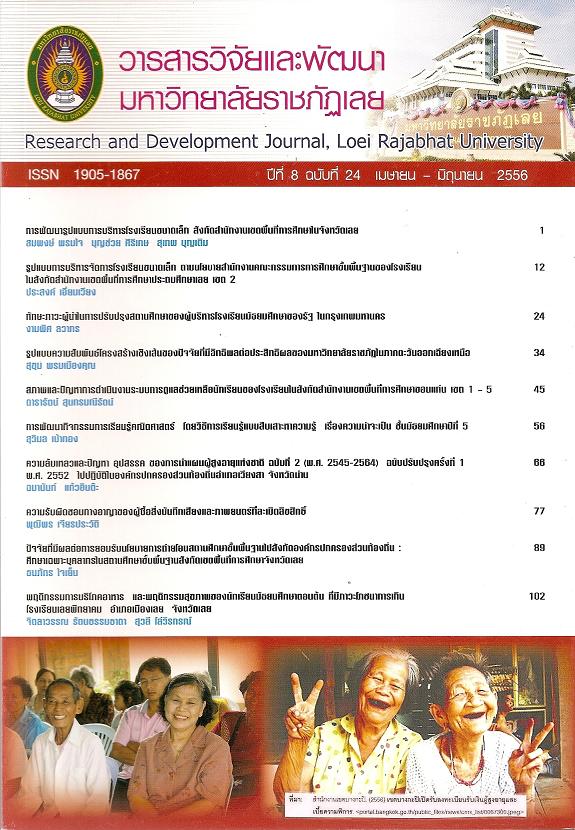การพัฒนากิจกรรมการเรียนรู้คณิตศาสตร์ โดยวิธีการเรียนรู้แบบสืบเสาะหาความรู้ เรื่องความน่าจะเป็น ชั้นมัธยมศึกษาปีที่ 5
Keywords:
การพัฒนากิจกรรมการเรียนรู้คณิตศาสตร์, กิจกรรมการเรียนรู้แบบสืบเสาะหาความรู้, a development of mathematics learning, activities base on inquiry approachAbstract
บทคัดย่อ
การวิจัยครั้งนี้ มีความมุ่งหมายเพื่อ1) พัฒนากิจกรรมการเรียนรู้คณิตศาสตร์ เรื่อง ความน่าจะเป็น ชั้นมัธยมศึกษาปีที่ 5 โดยวิธีการเรียนรู้แบบสืบเสาะหาความรู้ และวิธีการเรียนรู้แบบปกติ ที่มีประสิทธิภาพตามเกณฑ์ 75/75 2) หาดัชนีประสิทธิผลของกิจกรรมการเรียนรู้คณิตศาสตร์ เรื่อง ความน่าจะเป็น ชั้นมัธยมศึกษาปีที่ 5 โดยวิธีการเรียนรู้แบบสืบเสาะหาความรู้ และวิธีการเรียนรู้แบบปกติ 3) เปรียบเทียบผลสัมฤทธิ์ทางการเรียน วิชาคณิตศาสตร์ เรื่อง ความน่าจะเป็น ชั้นมัธยมศึกษาปีที่ 5 โดยวิธีการเรียนรู้แบบสืบเสาะหาความรู้ และวิธีการเรียนรู้แบบปกติ 4) เปรียบเทียบความสามารถในการคิดวิเคราะห์ ทางคณิตศาสตร์ เรื่อง ความน่าจะเป็น ชั้นมัธยมศึกษาปีที่ 5 โดยวิธีการเรียนรู้แบบสืบเสาะหาความรู้ และวิธีการเรียนรู้แบบปกติ 5) ศึกษาความพึงพอใจในการเรียนรู้ วิชาคณิตศาสตร์ เรื่อง ความน่าจะเป็น ชั้นมัธยมศึกษาปีที่ 5 โดยวิธีการเรียนรู้แบบสืบเสาะหาความรู้ และวิธีการเรียนรู้แบบปกติ กลุ่มตัวอย่างที่ใช้ในการวิจัยครั้งนี้ ได้แก่ นักเรียนระดับชั้นมัธยมศึกษาปีที่ 5 โรงเรียนหนองบัวแดงวิทยา ที่เรียนในภาคเรียนที่ 2 ปีการศึกษา 2554 จำนวน 2 ห้องเรียน ได้แก่ ชั้นมัธยมศึกษาปีที่ 5/8 จำนวน 39 คน และ ชั้นมัธยมศึกษาปีที่ 5/7 จำนวน 33 ได้จากวิธีการสุ่มแบบกลุ่ม (Cluster random sampling) เครื่องมือที่ใช้ในการวิจัย ได้แก่ แผนการจัดกิจกรรมการเรียนรู้แบบสืบเสาะหาความรู้ และแผนการจัดกิจกรรมการเรียนรู้แบบปกติ จํานวนรูปแบบละ 18 แผน แบบทดสอบวัดผลสัมฤทธิ์ทางการเรียน วิชาคณิตศาสตร์ เรื่องความน่าจะเป็น แบบทดสอบวัดความสามารถในการคิดวิเคราะห์ วิชาคณิตศาสตร์ และแบบวัดความพึงพอใจในการเรียนรู้ วิชาคณิตศาสตร์ สถิติที่ใช้ในการวิเคราะห์ข้อมูล ได้แก่ ค่าเฉลี่ย ร้อยละ ส่วนเบี่ยงเบนมาตรฐาน และสถิติทีที่กลุ่มตัวอย่างเป็นอิสระจากกัน
ผลการวิจัยปรากฏดังนี้
1. แผนการจัดกิจกรรมการเรียนรู้ คณิตศาสตร์ โดยวิธีการเรียนรู้แบบสืบเสาะหาความรู้ และวิธีการเรียนรู้แบบปกติ มีประสิทธิภาพ เท่ากับ 77.01/78.53 และ 75.39/75.15 ตามลำดับ ซึ่งสูงกว่าเกณฑ์ 75/75 ที่ตั้งไว้
2. ดัชนีประสิทธิผลกิจกรรมการเรียนรู้ โดยวิธีการเรียนรู้แบบสืบเสาะหาความรู้ และวิธีการเรียนรู้แบบปกติ เท่ากับ 0.7134 และ 0.6733 ตามลำดับ ซึ่งหมายความว่านักเรียนมีคะแนนผลสัมฤทธิ์ทางการเรียนเพิ่มขึ้นร้อยละ 71.34 และ 67.33 ตามลำดับ
3. นักเรียนที่เรียนโดยกิจกรรมการเรียนรู้ แบบสืบเสาะหาความรู้ มีผลสัมฤทธิ์ทางการเรียน สูงกว่านักเรียนที่เรียนโดยกิจกรรมการเรียนรู้แบบปกติ อย่างมีนัยสำคัญทางสถิติที่ระดับ .05
4.นักเรียนที่เรียนโดยกิจกรรมการเรียนรู้แบบสืบเสาะหาความรู้ มีความสามารถในการคิดวิเคราะห์ วิชาคณิตศาสตร์ สูงกว่านักเรียนที่เรียนโดยกิจกรรมการเรียนรู้แบบปกติ อย่างมีนัยสำคัญทางสถิติที่ระดับ .05
5. นักเรียนที่เรียนโดยกิจกรรมการเรียนรู้แบบสืบเสาะหาความรู้ และนักเรียนที่เรียนโดยกิจกรรมการเรียนรู้แบบปกติ มีความพึงพอใจในการเรียนรู้ อยู่ในระดับมาก
Abstract
The purposes of this research were 1) to develop learning activity of mathematics base on inquiry approach and the conventional approach entitled Probabity for Matthayomsuksa 5 students with a required efficiency of 75/75, 2) to find out effectiveness indices of those two types of learning activities, 3) to compare mathematics learning achievement of Matthayomsuksa 5 students between learning activities base on inquiry approach and the conventional approach, 4) to compare analytical thinking abilities in mathematics of Matthayomsuksa 5 students between learning activities base on inquiry approach and the conventional approach, and 5) to examine students’ satisfactions with learning activities by using those two approaches. The sample used in this study consisted of 72 Matthayomsuksa 5 students attendingNongbuadaengwitayaSchoolin the second semester of the academic year 2011. They were assigned to each group of the experimental group and the control group, with 39 and 33 students of Matthayomsuksa 5 group 5/8 and group 5/7 respectively using the cluster random sampling technique. The experimental group organization inquiry learning approach and the control group used organization conventional learning approach. The instruments used in the study were : plans for organization of learning activities using inquiry approach and using conventional approach. The plans included of a total of 18 hours of teaching, a 40–item achievement test, a -30 item test on analytical thinking ability and a 20 – item rating–scale questionnaire on learning satisfaction with learning by using inquiry approach and conventional approach. The statistics used for analyzing the collected data were mean, percentage, and standard deviation and the t–test (Independent samples) for testing hypotheses. The results of the study were as follows :
1. The plans for organization of learning activities base on inquiry approach and the conventional approach entitled Probability had efficiencies of 77.01/78.53, and of 75.39/75.15; which were congruence to the required criterion of 75/75.
2. The effectiveness indices of learning activities base on inquiry approach and the conventional approach were 0.7134 and 0.6733 showing that the students progressed their learning at 71.34 percent and 67.33 percent efficiency respectively.
3. The students who learned using the learning activities base on inquiry approach indicated learning achievement more than students who learned using the conventional approach at the 0.05 level of significance.
4. The students who learned using the learning activities base on inquiry approach indicated thinking ability toward mathematics more than students who learned using the conventional approach at the 0.05 level of significance.
5. The students showed satisfaction with learning activities base on inquiry approach and the conventional approach as whole at a very high level.
Downloads
How to Cite
Issue
Section
License
ข้อความที่ปรากฎในวารสารฉบับนี้เป็นความคิดเห็นของผู้เขียนแต่ละท่าน สถาบันวิจัยและพัฒนา มหาวิทยาลัยราชภัฏเลย และกองบรรณาธิการ ไม่จำเป็นต้องเห็นด้วยและไม่มีส่วนรับผิดชอบใดๆ
สถาบันวิจัยและพัฒนา มหาวิทยาลัยราชภัฏเลย ขอให้ผู้อ่านอ้างอิงในกรณีที่ท่านคัดลอกเนื้อหาบทความในวารสารฉบับนี้






